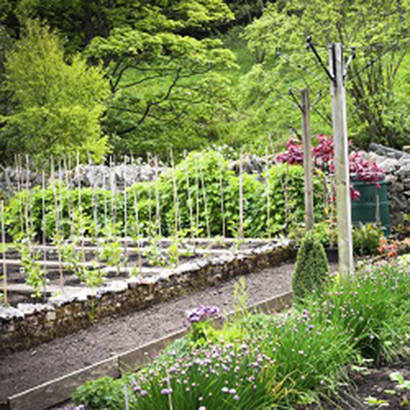
The JD Rivers’ Children’s Garden is located in Theodore Wirth Park in north Minneapolis. Since it was built in 1982, the garden has provided programs for children and teens, horticulture therapy for people with disabilities, and intergenerational programming with recent immigrants. Use of the garden is available to groups of children from the summer day-camps, after-school programs, and the daycare program operated by the Park and Recreation Board, school groups, and groups from other organizations. The Children’s Garden provides these groups with staff, programming, water, seeds, plants, and gardening supplies. Most children who use the garden are elementary school age, although summer youth employment programs send teens to work in the garden. Although a wide range of children’s groups use the garden, its main target group is children from low-income neighborhoods, especially from the Near North and Phillips neighborhoods. Most of the children are African-American, East African immigrants, or Latino.
The main objectives of the garden program are to teach children gardening skills and healthy eating habits and to provide a hands-on nature experience. The children eat the food they grow and if there is excess, they take it home to their families or it is donated to local food shelves. The staff also provides education on “green careers”, especially for teens who work in the garden.
MaryLynn Pulscher, Parks and Recreation Environmental Education Coordinator, who operates the Children’s Garden, explained that funds from the NRPA grant were used to enhance the garden’s long-term sustainability by buying perennial plants, improve the garden’s physical infrastructure, and develop new, intergenerational programming. Most of the garden space is allocated to annual vegetables. However, the children indicated a desire for more fruit crops, so fruit plants and fruit bushes were added to the garden. New physical infrastructure will include building compost bins, cold frames, and raised beds and extending existing water lines. These improvements will enable the garden to be planted earlier in the season and the crops to grow faster. A soil improvement project was undertaken so that more of the garden space could be productively cultivated. Garden staff will also be piloting an intergenerational program in which children from Parks and Recreation camps will bring their parents or grandparents for “canning and jamming” classes. Ms. Pulscher also has an interest in developing programs around the food of the many ethnic groups in Minneapolis.
Ms. Pulscher has developed a number of partnerships to maintain and improve the garden. Local nurseries donate plants, and local businesses have sold the program supplies, such as canning jars, at bulk prices. Master Gardener volunteers help lead programs. Working with Audubon Minnesota and the Bryn Mawr Neighborhood Association, they added a chimney swift tower to the garden during the 2010 growing season. Residents of nearby Bryn Mawr also volunteer in the garden. In addition, Best Buy and the Target Corporation provide volunteers. The Nordic Ski Foundation runs summer day-camps, and the Children’s Garden provides the gardening and nutrition education programming. In the winter, the Nordic Ski Foundation runs Parks and Rec’s cross-country skiing program.
One of the main challenges the garden program has faced, according to Ms. Pulscher, is transportation. The garden is located in a 700-acre park on the edge of the city and is not an easy walk from the surrounding neighborhoods. As a result, people need transportation to get there. Ms. Pulscher also pointed out that produce gardening is very time-intensive, and her staff are all part-time.
A measure of the garden’s success is that several of the groups that have used the garden in the past now have their own on-site gardens.
Ms. Pulscher believes that financial sustainability results from Parks and Recreation’s long-term commitment to the garden, partnerships, and volunteers. In addition, the NRPA grant was used to make permanent improvements in the garden’s physical and plant infrastructure. Cooperative arrangements like the one Parks and Recreation has with the Nordic Ski Foundation also contribute to sustainability.
